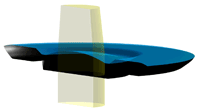This is actually quite big and I’m a bit surprised that no major camera or lens maker has yet bought up Swiss company Optotune for their ingenious invention of a focus tunable lens — or in other words: of optics that are no longer based on solid glass or plastic lenses that move back and forth to focus or zoom. Optotune’s revolutionary lenses focus and zoom as well, but without any parts moving back and forth. Their lenses consist of an elastic lens material which is bent in order to focus. That’s right, like the eye! Optotune has developed and patented a series of lenses that basically copy the principle of the eye. Just imagine what that means for the size of lenses. They shrink, get lighter and fit into smallest thinnest devices without losing the capability to focus or zoom.

These electrically and manually focus tunable lenses are shape-changing lenses based on a combination of optical fluids and a polymer membrane. The core element consists of a container which is filled with an optical liquid and sealed off with a thin, elastic polymer membrane. A circular ring that pushes onto the center of the membrane shapes the tunable lens. The deflection of the membrane and with that the radius of the lens can be changed by pushing the ring towards the membrane or by exerting a pressure to the outer part of the membrane or by pumping liquid into or out of the container.

The lens shape ranges from concave to flat to convex. This offers amazing advantages that could not only determine the future of lenses in portable devices. Imagine camera lenses that are no longer based on the old but very successful system of moving lens parts. A change in lens radius of several micrometers can have the same optical effect as moving the entire lens several centimeters. Optical systems can be designed more compact, oftentimes with less lenses and usually with less or no translational movement.
Accordingly, there is no more need for expensive mechanical actuators. Less movement also leads to a more robust design, which can be completely closed so that no dust can enter. Furthermore, the materials employed are lighter than glass, saving overall weight. Less movement and weight also means less power consumption and that the response time of systems with tunable lenses can be very low, in the order of milliseconds.

Optotune lists these five main advantages of focus tunable lenses over traditional optics:
- Compact design
- Less mechanics
- Fast response
- Low power
- Less tolerance sensitivity
That’s what I call “shaping the future of optics.” Focus tunable lenses are a somewhat mechanical solution to the age-old problem that physics determine the size of lenses. I would have thought that a solution lies rather in image processing than lens design. Might very well be that tomorrow’s lenses work as fast and reliable as the human eye.


